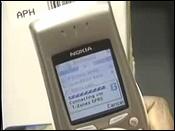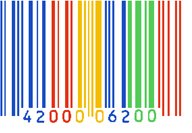A new way to shop by phone: in the store
By Tom Regan
I hate shopping, So when I head out, I tend to go where I think I can find what I need in a hurry. I seldom worry about price. I am to comparison shopping what Paris Hilton is to modesty - it's something I never consider.
The problem is, I often feel buyer's remorse. Many times, after returning home with my purchase, I discover (thanks to an ad in the newspaper or an Internet search) that I paid too much.
If only there was a way I could discover that fact while I was still in the store, I could save a bundle.
Lo and behold, that technology now exists. It's called Scanbuy Shopper. And some very smart people are suggesting that it has a very bright future that will make many retailers very, very nervous.
But more on that later. First, let's look at how it works.
According to the New York company's website (
http://www.scanbuy.com/), Scanbuy is a technology that "enables camera phones to capture and immediately decode printed or electronically displayed bar codes." Currently it works best with books, electronic equipment, and CDs.
When you're in a store and find an item of interest, simply take a picture of its bar code using an Internet-capable cellphone with a built-in camera. Then connect to the Web. (You don't have to take a picture. Instead, you can just punch the bar-code numbers into the phone.) Scanbuy checks prices at comparison-shopping websites such as PriceGrabber.com and Amazon.com's Marketplace. It then sends you information on the best prices.
I downloaded Scanbuy software onto my data-enabled cellphone (it's a pretty simple process - connect to the Internet on your cellphone and go to wap.scanbuy.com) and tried it at a local electronics store. I checked on the price of a video camcorder, which sold in the store for about $399. Scanbuy indicated that I could purchase the same camcorder online for about $30 less.
Pretty cool, eh?
Scanbuy, however, does have a few shortcomings. Not every cellphone is compatible with the service. And spending too much time on your cellphone conducting price searches can be costly, depending on the terms of your cellphone contract. Other people who have reviewed Scanbuy have written that many retailers use proprietary bar-code systems that don't show up in any of the search engines used by Scanbuy - at least not at the moment.
But as I mentioned earlier, some people see bigger things in Scanbuy's future, particularly working with the search industry's 800-pound gorilla, Google.
Mark Otuteye, a researcher at Stanford University, writes the GoogleWatch blog, which follows the various areas and industries into which Google is expanding. He recently posted a piece called "Ten Products That Google Could Develop." Along with ideas like Google Billboards (as you walk by a digital billboard, a signal from your cellphone would tell the board to show items that might interest you) and Google Travel Sing and Draw Search (where you would sing a few bars of a song you don't know into your cellphone, and Google would find the song, and give you the chance to buy a copy), Mr. Otuteye also proposed Google Bar Code.
Working with Google's Froogle shopping service, and combined with Scanbuy's online-shopping technology, Google Bar Code would not only find better prices online, it would find them in the vicinity of where you are shopping - and show you how to get there. Otuteye wrote that this kind of service could also signal the merchants in the store where you are shopping, so they could offer you a lower price to buy the item there.
If it all sounds too good to be true - it is, a little, says Tamara Mendelsohn, an analyst on Forrester Research Consumer Marketing team. It's not that this kind of shopping by cellphone is a bad idea, she says - in fact, one day it will be widely accepted, as it is in Europe and Asia.
But right now, the idea has some big obstacles to overcome.
"It took the Web about 10 years to gather mainstream acceptance," Ms. Mendelsohn says, "and while many people use cellphones, not many are ready to use them for this kind of activity yet. Only about one-quarter of cellphone users in the US even use text messaging." The number of consumers using a "data enabled phone" needed for this kind of activity is even smaller.
Even so, Mendelsohn says the technology holds the potential to significantly change the way people shop, especially since "the one thing the Internet has taught us is that people like to have control over their shopping experience."
Note: Scanbuy is not the only company developing this kind of technology. NextCode Corp.'s ConnexTo (
http://www.connexto.com/) can also read digital bar codes on packaging, as can NeoMedia's PaperClick (
http://www.paperclick.com/).
I can already see that I will use Scanbuy more often when I go shopping, especially when I haven't had the opportunity to look for a cheaper deal online before I head to the store.
Who knows? I might actually start to like shopping ... OK, maybe I won't go that far. But at least I won't hate it quite so much.














